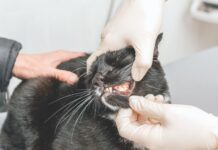About once every month or two my three-year-old cat will suddenly run throughout the house and then throw himself on the floor and shake uncontrollably. He sometimes foams at the mouth and loses control of his bladder. This lasts for several minutes, then afterwards he looks confused and disoriented. Within an hour or so hes back to his old self. My veterinarian ran some tests, but found nothing. What can be causing this?
It sounds as though your cat is experiencing seizures. Seizures in cats usually have three recognizable stages. Your cats running from room to room is the preictus or aura stage. Behavior during preictus varies from cat to cat; for example, some cats hide, some act nervous, others seek attention, and some freak out like your cat. Preictus usually lasts anywhere from a few seconds up to a few hours prior to the onset of the violent phase of the seizure, the ictus.
During ictus (which, thankfully, usually lasts no more than a minute or two), seizuring cats lose consciousness, fall on their side, either paddle or have violent muscle contractions, and often foam at the mouth. Sometimes they lose control of their bladder or bowels.
After the ictus comes postictus, a period during which unusual – sometimes bizarre – behaviors can be manifested. Some cats act disoriented, some are sleepy, some are aggressive, and some even act deaf or blind. Others pace and act restless, are either depressed or excited, or have ravenous appetites. Postictus can last up to a couple of days but usually lasts less than an hour.
Generalized seizures have many possible causes. Their potential for harm depends to a major extent on their underlying cause and its severity. The cause may be in the brain itself; a very partial list of possibilities would include a brain tumor, a congenital defect such as hydrocephalus (fluid putting pressure on the brain), inflammation or an infection involving the brain (like toxoplasmosis or feline infectious peritonitis), a migrating parasite like a Cuterebra larva or severe head trauma. The cause could originate from elsewhere in the body: acquired or congenital liver disease, severe kidney failure, low blood sugar or poisoning, to list just a few. Or the seizures may be a result of idiopathic epilepsy, a disease with an unknown cause. Idiopathic epilepsy is one of the most common causes of seizures in dogs-and is an inherited disease in some breeds – but its relatively rare in cats.
Diagnosis: Not Always Easy
Diagnosing the cause of seizures can be a real challenge. Delivering an accurate report to your veterinarian is the first step. Expect questions like:
What do the seizures look like? (Your veterinarian may ask you to videotape an episode if possible.)
When do they occur (for example, when asleep, when eating or when excited)?
How often do they occur and how long do they last?
How old is your cat? (Some causes of seizures are much more common in young cats, while others are more common in older cats.)
What does your cat eat?
Is your cat taking any medication?
Has your cat had access to toxins like lead paint chips or pesticides?
Is there any history of injury?
Is your cat normal between seizure episodes?
Are there other signs of illness?
A thorough physical examination, including a neurological examination, follows. Blood tests (including a complete blood count, blood chemistry, and a screen for feline leukemia virus and feline immunodeficiency virus infections) and urine analysis will be next. In some cases, more testing is necessary. Examples include toxicology screens if exposure to a poisonous substance is suspected, cerebrospinal fluid analysis and special imaging techniques – CT scans and magnetic resonance imaging.
A Happy Outcome…In Many Cases
If a treatable underlying cause is discovered and resolved, then the seizures may resolve in time, too. On the other hand, if seizures are the result of a progressive or intractable physical malady like severe liver disease or kidney failure, the prognosis is much less rosy; the underlying disease may be much more life threatening than the seizures themselves.
Many cats with recurring seizures act just fine between episodes, have normal findings on physical and neurological examination, and receive normal diagnostic test results. In most of these cases a good prognosis can be given…but with some reservation. Even if an underlying disease isnt found, that doesnt necessarily mean there isnt one; remember, some of the potential causes can be extremely difficult to diagnose. If there is a disease-and it progresses-the outlook can become bleak.
Barring this possibility, the major goals of therapy are to stop or reduce the severity or frequency of the seizures. Infrequent seizures of less than a few minutes duration usually dont, in themselves, pose a serious health risk. (However, seizures that last for more than several minutes or that appear in rapid succession require immediate veterinary care.) As no anticonvulsant drug is totally free of side effects, most veterinarians wont consider medication if a cat has had fewer than three seizures over time. Even then, drug therapy is usually considered only if the seizures have occurred more frequently than every four to six weeks, or if the cat has had more than one cluster seizure – seizures that occur in quick succession over a short period – every two to three months. Cats that require anticonvulsant therapy will probably need it for the rest of their lives, but side effects are usually minimal and easily controlled.



